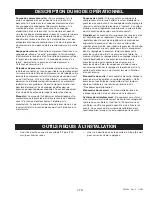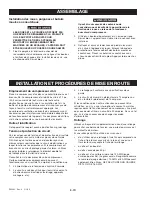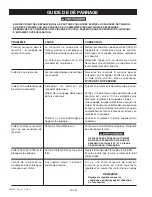
11 — ENG
D20982 Rev. 0 5/3/00
ALL MAINTENANCE AND REPAIR OPERATIONS NOT LISTED MUST BE DONE BY QUALIFIED SERVICE PERSONNEL.
Safety Valve - Inspection
If the safety valve does not work properly,
over-pressurization may occur, causing air
tank rupture or an explosion. Before
starting compressor, pull the ring on the
safety valve to make sure that the safety
valve operates freely. If the valve is stuck
or does not operate smoothly, it must be
replaced with the same type of valve.
Storage
Before you store the air compressor, make sure you
do the following:
1.
Review the “Maintenance” and "Operating
Procedures" sections and perform maintenance
as necessary. Be sure to drain water from the air
tank.
2.
Protect the electrical cord and air hose from
damage (such as being stepped on or run over).
Wind them loosely around the compressor
handle.
Store the air compressor in a clean and dry location.
Check Valve - Replacement
Before servicing:
•
Unplug or disconnect electrical supply
to compressor.
•
Bleed tank of pressure.
•
Allow compressor to cool.
1.
Release all air pressure from air tank and unplug
outfit.
2.
Loosen the bottom nut and move the outlet tube to
the side.
3.
Unscrew the check valve (turn counterclockwise)
using a socket wrench.
4.
Check that the valve disc moves freely inside the
check valve and that the spring holds the disc in
the upper, closed position. The check valve may be
cleaned with a solvent, such as paint and varnish
remover.
5.
Apply sealant to the check valve threads. Reinstall
the check valve (turn clockwise).
6.
Replace the outlet tube and tighten the bottom nut.
MAINTENANCE
UNIT CYCLES AUTOMATICALLY WHEN POWER IS ON. WHEN DOING MAINTENANCE, YOU MAY
BE EXPOSED TO VOLTAGE SOURCES, COMPRESSED AIR OR MOVING PARTS. PERSONAL
INJURIES CAN OCCUR. BEFORE PERFORMING ANY MAINTENANCE OR REPAIR, UNPLUG THE
COMPRESSOR AND BLEED OFF ALL AIR PRESSURE.












































